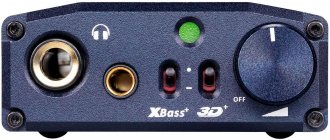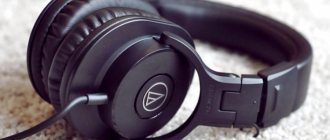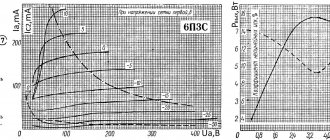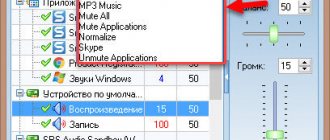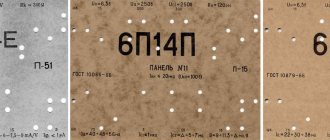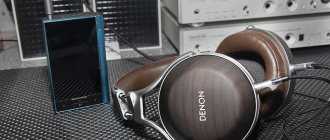Review of budget portable iFi devices
It is not customary to expect outstanding musical abilities from budget portable audio. But there are exceptions to every rule: when it comes to budget iFi models, we have every reason to be seriously interested. After all, the developers of these devices have an important head start over their competitors - access to the most advanced High End developments of Abbington Music Research, a reputable company in the audiophile community, which is the founder of this brand. Today we are getting acquainted with three iFi models - each of them stands out not only with an affordable price tag, but also with extraordinary engineering solutions that iFi designers borrowed from Abbington Music Research home devices and successfully adapted to the features of portable audio.
iFi nano iDSD
The iFi catalog is full of miniature gadgets that do not require extra space in your bag and can easily fit into almost any pocket. But the models in the nano line stand out for their compact dimensions even against this background: their size and weight are about a third less than that of portable iFi devices from the main model range. Here is a typical representative of this line - a microscopic DAC/amplifier with a weight of 163 g. However, the word “typical” in this case is not entirely appropriate, because in terms of its combination of compactness, functionality and musicality, this iFi model has no analogues not only among iFi, but also in the entire portable market today. No other miniature DAC/amplifier combo is capable of processing such high-resolution audio raw materials!
Nano iDSD really takes on burdens that others cannot handle - for example, PCM with up to 32 bits and sampling up to 384 kHz, as well as single-bit DSD265 with a resolution of 11.2 MHz. Moreover, unlike most budget devices aimed at processing DSD formats, iDSD copes with this task without first converting them to PCM. This fully fits into the proprietary True Native concept, according to which each music format must be processed in its original form, without conversion from single-bit to multi-bit form or vice versa.
This problem is solved in iDSD through the use of a vintage digital-to-analog converter from Burr-Brown with hardware support for single-bit and multi-bit audio processing circuits. Careful work on eliminating unnecessary links in the signal processing chain is noticeable not only in the digital-to-analog, but also in the iDSD amplifier block - when designing it, iFi engineers gave preference to the most concise circuit without coupling capacitors at the output.
The Zero Jitter technology, which is responsible for eliminating jitter, was borrowed by the device developers from the arsenal of Abbington Music Research, which successfully tested it on its cult CD player AMR DP-777. The built-in lithium-polymer battery not only provides the iDSD with a very good 10-hour autonomy, but also allows it to do without noisy power via the USB bus when working in conjunction with a computer or laptop. But the most interesting thing is the device’s ability to work not only with laptops, but also with mobile gadgets - for example, with smartphones running iOS or Android. It is enough to connect any of these devices to the iDSD using an adapter or USB-OTG cable to turn it from a simple mobile phone into a Hi-Fi-level pocket transport!
iFi Nano iOne DAC/Interface Converter
Music lovers of the current generation most often start listening to music on smartphones and portable players, but with age they usually switch to stationary systems. Do you think they will buy black heavy boxes? Of course not, their new systems will also be compact. Miniaturization has become a trend. And here is one of its manifestations: the iOne stationary DAC from the British company iFi Audio.
Perhaps someone has a question: why should today’s young music lovers necessarily switch to stationary equipment? Why won't it disappear over time, being replaced by portable ones?
The first reason: batteries. Sometime in the distant future, perhaps all technology will become portable, but first there must be a breakthrough in energy production and storage technologies. It is not expected in the foreseeable future.
Second: acoustics. Speakers that can approach the realism of a live performance cannot be portable - the laws of physics do not allow this. Pay attention to how wireless portable speakers are advertised - they show us carefree youth parties. Yes, it's great for getting drunk. But you won’t see a person in advertising listening to a Mahler symphony on Bluetooth speakers. Although who knows, anything is possible in advertising.
A miniature and at the same time stationary DAC is not a curiosity, but a manifestation of the main trend.
Where acoustics arise, an amplifier necessarily appears. And until the above-mentioned breakthrough in energy storage is made and miniature batteries with high voltage and discharge current of several amperes appear, serious amplifiers will remain stationary. Even if they are compact, they have a cord that needs to be plugged into an outlet.
Yes, sources can be portable - personal music players and DACs comparable in sound quality (and price) to stationary equipment have been produced for a long time. But they will not be able to dominate the market in the foreseeable future. The reason is still the same: batteries.
Their service life is a maximum of two years. How many portable players and DACs have you seen that have a user-replaceable battery? Personally, I know of only one such device. But there are still no batteries for it on the market. Replacing a battery in a workshop will cost a lot of money, and it is not a fact that there will be a suitable one there. A smartphone usually becomes obsolete within a couple of years, so the idea of replacing the entire device doesn’t seem crazy. In audio technology, progress does not happen so quickly. And replacing a serious music player (which can cost several times more than a smartphone) just because its battery is dead is an unaffordable luxury. And stationary equipment can (and should) last for years. That is why a miniature and at the same time stationary DAC is not a curiosity, but a manifestation of the main trend.
When you realize that you won’t be allowed to say everything you could, you must convey to your interlocutor the most important thing.
However, there is one problem: the smaller the device, the more difficult it is to achieve high quality performance from it - regardless of whether it is portable or stationary. By the way, some uncompromising audiophiles do not recognize surface mounting at all, one of the integral production bases of miniaturization. So the trend towards reducing the size of equipment is unlikely to threaten the High End segment - the demand for large-sized equipment will remain stable. But the number of compact models of the highest class will increase as technology develops.
Matryoshka principle
Where does the small British company iFi Audio get the advanced technologies to create high-quality and at the same time compact equipment? How from? From parents! iFi Audio is a subsidiary of Abbingdon Music Research, which itself is a division of the large international concern Abbingdon Global Group. AMR is not only one of the largest British manufacturers of high-end equipment, but also a powerful research center that generates technologies and licenses them to its subsidiary.
In particular, it is Global Master Timing® - a femtosecond precision clock system that virtually eliminates jitter - it is also used in the famous AMR DP-777 digital-to-analog processor. And also Active Noise Cancellation® - to clean the voltage that the device receives via the power bus of the USB interface, the same principle is used as in headphones with active noise reduction: first, a noise signal is separated from the constant voltage, then it is inverted in phase and mixed with the original — identical antiphase signals cancel each other, and the power supply becomes absolutely clean. In words this seems very simple, but in reality it is quite difficult to implement, since all manipulations with the noise signal must take place almost instantly.
We live in the era of smartphones, which means that the ability to connect a device to our main “mobile friend and master” is becoming almost mandatory.
Another iOne feature is complete galvanic isolation for the S/PDIF digital interface (our hero has the input and output combined on one RCA connector and switches automatically: when connected to a computer via USB, this connector becomes an output connector). Moreover, signals transmitted via the S/PDIF interface are processed by the proprietary REclock®/REgenerate® circuit, that is, they undergo resynchronization and regeneration, completely eliminating noise and jitter. From a technical point of view, there is nothing extraordinary in this - the very fact of using solutions usually used in top-end digital devices in an inexpensive compact model is unusual. If iFi were an independent company, it would hardly be able to afford this, but in the role of the smallest internal element of a “matryoshka” it would be easy. By the way, in the already mentioned AMR DP-777 S/PDIF receiver is built on 6N11 lamps, which made it possible to rid it of feedback.
Trend No. 2
Hand in hand with the first trend, miniaturization, comes the second: combining many functions in one device. If earlier “combines” were made for the sake of economy, and high-end equipment was always specialized (to the point that the components of the devices are separated into separate housings - phono stages, power supplies, etc.), now the combination of functions is based on the internal architecture of the equipment and inherent in it from the very beginning. Let me explain my idea using the iFi iOne as an example.
Let's say the developers have conceived a compact digital-to-analog converter with a USB interface. Adding a coaxial input and output to it costs a penny, and the value of the device for the consumer immediately increases. Moreover, it acquires another function - a high-quality USB > Coaxial interface converter. And it becomes even more attractive to potential buyers. Here it’s time to remember that we live in the era of smartphones, which means the ability to connect a device to our main “mobile friend and master” becomes almost mandatory. Well, adding a miniature Bluetooth module to the device is not so difficult, and it won’t cost too much even with all the licenses, but the device acquires a very popular function. Moreover, iOne has a Bluetooth interface with support for the aptX codec, which means you can count on decent sound quality.
The front and rear panels are not made of aluminum, like the entire body, but of milky white acrylic.
The presence of a wireless interface explains some deviations from the traditional iFi design: the front and rear panels are made not of aluminum, like the entire body, but of milky white acrylic. For my taste, it is very fresh and beautiful. Frosted windows on the sides probably also contribute to better performance of the internal antenna.
A serious approach to design is manifested, in particular, in the fact that all controls are concentrated on the front panel, and connectors on the rear panel. Would you say this is how it should be? I know quite a few compact devices whose inputs and outputs are located on opposite sides - this makes wiring easier. But the convenience of the user and the fact that their device with cables becomes like a boa constrictor that swallowed a suitcase - the developers do not care about this.
The iOne has few controls: on the left is a black Bluetooth pairing button, next to it is a round indicator window, the logo in which changes color and blinks depending on what it wants to display. To the right is a toggle switch for selecting a digital input (Bluetooth, USB, S/PDIF), the far right two-position switch selects the filter type, and the positions are indicated in the most understandable way for an untrained user: the correct position is to listen, the lower position is to take measurements. In fact, this switches the characteristics of the digital filter in the DAC: as far as I can judge from the sound, the first position is with a smooth decline, the second is with a steep decline. However, the effect of this filter depends on the type of signal: everything said above applies to PCM. When playing DSD streams, the filter becomes analog and cuts out high-frequency interference, and with DXD it provides bit-perfect transmission of the stream in the upper position.
The digital-to-analog converter is built on a Burr-Brown chipset, but which one is not reported. It's actually not that important. The British from iFi are very careful when choosing components: they will not save an extra penny on parts at the expense of quality, but they will not install an overly expensive microcircuit, all of whose capabilities cannot be implemented in a particular device.
They know you
Another strong quality of the company is a clear idea of who a particular model is intended for. For example, the iFi Micro iDSD DAC with headphone amplifier was developed based on long-term conversations with personal audio enthusiasts on popular online resources. But for iOne, communication with the people was not required, since it is aimed at young people who have just started assembling their home systems and have not yet fully understood in which direction their development will go. It is useless to ask their opinion, but to suggest the right path is necessary.
The main purpose is to serve as a link between portable equipment (smartphone and laptop) and stationary equipment
The main purpose is to serve as a link between portable equipment (smartphone and laptop) and stationary equipment (amplifier with speakers or headphones, home theater, mini-system, etc.). And to do this with high quality, that is, better than standard tools allow. If over time the owner of the device gets a taste for it and has acquired a serious DAC, the iOne will come in handy as a USB > Coaxial interface converter, and given the proprietary technologies implemented in it, it is likely that it will give better results than its own USB interface of an external DAC. You cannot do without such a device if the “main” DAC does not have a USB interface at all (and there are such converters, and quite interesting ones at that). All these, of course, are assumptions, but we will now test them, and in conditions that are quite difficult for an iFi baby.
Open category
For people far from sports, I’ll explain: the open category is a special type of competition in wrestling, when athletes of any weight compete on the mat. In judo this is called the absolute category, only there the opponents go out onto the tatami rather than onto the mat.
In fact, in sports there is no such difference in weight between wrestlers as in our audition. iFi iOne weighs only 122 g, and we will compare its sound with a DAC weighing more than 11 kg - PS Audio PerfectWave DAC MkII. It is, of course, not so young, but it has an advanced digital path with Digital Lens technology, and its USB interface is built on the same platform as the iOne - XMOS. By the way, this is not indicated in the documentation for either converter. But this is easy to determine from the drivers. In addition, I opened the device from PS Audio and know exactly what is inside it.
First, we compare the sound of two converters connected via USB to one computer digital transport. To compare, you have to switch not only the amplifier inputs, but also the output drivers of the Foobar2000 player. But this is done quickly, so the “imprint” of the sound of the previous device does not have time to disappear from memory. Moreover, in our case the difference is great.
In sports, there is no such difference in weight between wrestlers as in our audition.
The American sounds soft and noble, detailed, but without close attention to unimportant details. The scene is slightly out of focus. The little Briton's sound space becomes more compact and dense. He shows even less interest in details - he seems to paint the sound picture with larger strokes, and if PS Audio paints with pastels, then iFi paints with oils. Oddly enough, but due to this it is even more expressive and musical, since it highlights the main thing. This speaks of the high skill of British developers: they quite reasonably assume that their compact converter will be used with an amplifier and acoustics of not the highest class, so it will have to “break through” a path with a reduced resolution. When you realize that you won’t be allowed to say everything you could, you must convey to your interlocutor the most important thing.
From rivalry to cooperation
Let's see how the Bluetooth interface works. The pairing procedure is standard and does not cause any difficulties. When switching to a wireless interface, the coaxial connector continues to work as an output, so we can choose whether to connect digitally to an external DAC or analoguely to an amplifier.
In both versions he plays surprisingly convincingly. A little simpler than when connecting to a digital source via USB, but just as exciting. If you play back files in standard resolution 16-bit/44.1 kHz, the difference is minimal, but with material in Hi-Res it becomes noticeable, since the signal is forced to 44.1 kHz before being sent to the wireless interface, regardless of the original sampling frequency . Well, we need Bluetooth not for super quality, but for convenience and a sense of freedom.
If PS Audio paints with pastels, then iFi paints with oils.
We disconnect the iFi iOne from the amplifier and connect it via coax to PS Audio. We transfer the USB cable from one converter to another - in essence, we compare the operation of asynchronous USB interfaces. The result was quite predictable: the general character of the sound did not change, but the use of iFi iOne as an interface converter gave a significant increase in quality. The stage became focused and transparent, the bass became clearer, and the vocals literally came to life. The sound picture retained its softness and nobility, but was supplemented with many details - albeit not very important, but useful - increased realism and naturalness. And due to this, the emotional impact increased.
Not long ago I listened to the iFi iPurifier2 USB interface “purifier” with a PS Audio DAC - the positive effect was very noticeable, but with the iOne it was even more so. The amount you invest in upgrading old equipment is the same amount you get in sound. At least that's the case with iFi hardware.
iFi Nano iOne
Manufacturer: iFi Audio (UK)
www.ifi-audio.com
Power supply: USB bus, 5V || Input signals: PCM up to 24 bit/44.1/48/88.2/96/176.4/192 kHz; DSD 2.8/3.1/5.6/6.2/11.2/12.4 MHz; DXD 352/384 kHz || DAC Chipset: Burr Brown || Inputs: USB 3.0 (compatible with USB 2.0), Bluetooth (with aptX and AAC support), SPDIF (coaxial and optical on one combo connector) || Outputs: S/PDIF (with active USB/Bluetooth inputs), analog stereo (2 x RCA) || Frequency range (-0.5 dB): 20 Hz - 20 kHz || Output voltage: 2.0V || Dynamic Range (A-weighted): 109 dB || Signal-to-noise ratio (A-weighted): 109 dB || Harmonic distortion + noise: <0.0015% || Output impedance: <50 ohms || Power consumption: <2.5W || Dimensions: 100 x 64 x 25.5 mm || Weight: 122 g || Price (recommended): 15,812 .
COMPONENTS
- Acoustics Yamaha Soavo-1
- Integrated amplifier Musical Fidelity A5-INT
- External DAC: PS Audio PerfectWave DAC MkII
- Smartphone LG V10
- Speaker cables Tchernov Cable Classic IC
- Interconnect cables Musical Wire Cadence Signature
- Digital cables Audioquest Cinnamon USB, Furutech FX-Alpha-Ag
LISTENED
- Fantastic Negrito. "The Last Days of Oakland". FLAC 44.1 kHz/16 bit
- Led Zeppelin. "II". FLAC 96 kHz/24 bit
- Tim Bowness. "Songs From The Ghost Light". FLAC 44.1 kHz/24 bit
- The Gales Bros. "Left Hand Brand". FLAC 44.1 kHz/16 bit
- Pink Floyd. "Dark Side of the Moon". FLAC 96 kHz/24 bit
- Lizz Wright. "Freedom & Surrender". FLAC 44.1 kHz/16 bit, 96 kHz/24 bit
- Anthony Wilson. "Power Of Nine" DSD64
- McIntosh Spectacular Reference Disc. FLAC 192 kHz/24 bit
- Larry Adler and Various. “The Glory of Gershwin.” FLAC 44.1 kHz/16 bit
- Casualties of Cool. "Casualties of Cool". FLAC 44.1 kHz/16 bit
- Catherine Russell. "Harlem On My Mind" FLAC 96 kHz/24 bit
- Stacey Kent. "I Know I Dream: The Orchestral Sessions". FLAC 24 bit/44.1 kHz
share
Tags: iFiNano iOne
iFi nano iCan
This pocket-sized amplifier is the smaller cousin of the more expensive, larger and beefier micro iCan, one of the most successful models in the iFi micro line. Despite the reduction in cost and reduction in body size, the developers managed to squeeze most of the technical developments that made the older model widely known into a compact block of aluminum. Among them are two analogue sound correction systems that serve as a hallmark of iFi portable products.
The first of these, X-Bass, addresses the low-frequency dip that causes many headphones to underperform large speakers in a wide variety of music genres, from hip-hop to hard rock and techno to symphonic music. Unlike all sorts of “bass expanders” that we are familiar with from budget portable solutions, in this case the bass is raised correctly and delicately, without going overboard with the level and without going into the mid frequencies - thanks to this, the sound of music remains balanced and natural even at the maximum level X- Bass.
Another sound “corrector” - a two-stage 3D Holographic Sound system - is implemented on the basis of Crossfeed and is designed to eliminate another weak point in the sound of many headphones, associated with a rather peculiar spatial “picture” that they paint in the listener’s head. To take the sound of headphones far beyond the confines of the skull and make the stereo image more believable, 3D Holographic Sound uses channel mixing and other manipulations implemented purely by analog means, in full accordance with iFi's policy of minimizing digital audio signal processing.
The iCan owner has the opportunity to adjust not only the bass level and stereo width, but also the gain level - this is done using tiny switches on the bottom panel of the device. Thanks to their presence, the amplifier is able to unleash the musical potential of any headphones, regardless of their size, type of sound emitters, impedance and sensitivity. With such capabilities of the amplifier, combined with its light weight, you don’t expect outstanding battery life from it, but iFi engineers managed to present a pleasant surprise here: the built-in lithium-polymer battery with a capacity of 1400 mAh is enough for a mind-boggling 70 hours of battery life without additional charging! It is enough to feed the battery with electricity once - and you can forget about the next date with the outlet for a week. Or even for a whole fortnight!
iFi micro iUSB Power
This compact device does not process the audio signal, however, it can have a huge impact on the sound of a computer audio system, because its mission is to clean the power that the components of this system receive from a personal computer or laptop via the USB bus. Initially, this power is accompanied by significant background noise, which noticeably degrades all aspects of the sound of the audio system. It is precisely because of interference in the power supply that the lower register may lack speed and bite, the high frequencies may lack sonority and transparency, sharp sibilance may appear in vocals, and unpleasant nasal notes may appear in the sound of wind instruments. iUSB Power is designed to eliminate all these problems.
The miniature device wedges itself in the path of electricity from a computer USB port to the USB input of an external digital-to-analog converter to greatly reduce the level of noise and interference. To do this, it is equipped with a whole range of proprietary technologies. For example, the IsoEarth system, which opens the ground in the electrical circuit between the computer and the audio system. The IsoEarth function is activated by pressing a special key and can reduce background noise by about ten times. Another powerful tool for cleaning contaminated electricity is the proprietary Super Regulator filtration system. When used in conjunction with each other, these two technologies reduce the noise level of USB computer power by up to a thousand times, making it cleaner than power from a built-in battery.
And to eliminate the mutual influence of power and audio signals when transmitted over a common USB cable, iUSB uses additional IsoPower technology based on two separate USB outputs, as well as a special bifurcated iFI Gemini USB cable. Sound and electricity are transmitted by this cable through channels carefully isolated from each other, made of special oxygen-free copper, coated with reliable polyethylene insulation and protected by special double shielding based on aluminum foil and copper braid.
Everything will be clean! Both power and audio. The result can be easily discerned when listening.
We would like to thank the Doctorhead store for the equipment provided.
Author:
08.10.2015
Found a typo in the text?
Select and press
Ctrl+Enter
. This does not require registration. Thank you.
Review. iFi Audio. Pure USB interface
Abbingdon Music Research subsidiary iFi Audio is systematically and consistently pursuing the concept of a clean USB interface optimized for high-resolution audio transmission. The manufacturer considers the key technologies to be exact compliance with the requirements of the USB standard in terms of signal bus impedance (90 Ohms), battery power, physical separation of power and signal buses (IsoPower), thorough cleaning of the supply voltage (SuperRegulator) and signal (RF3, PurePurification) from penetrating from the computer noise and interference, separation of the earth of the source and receiver of the signal (IsoEarth), as well as conditioning of the signal itself (iPurifier - elimination of the constant component, radio interference filtering, rebalancing).
USB converters and DACs additionally use Jitter Elimination Technology JET and physical signal conditioning SPDIF (Super Digital Output - high-level balanced signal, galvanic isolation, exact impedance compliance with standard requirements, ultra-high slew rate).
The design of all devices is simple. Compact housings and distinctly large matte aluminum cable connectors, black braided cables, gold-plated contacts protected by soft plastic covers. Soft self-adhesive plastic legs. Solid weight for its size. A feeling of reliability in every detail.
Tested devices: iFi iDSD Nano and iFi iDSD Micro digital-to-analog converters, iFi iLink USB converter, iFi iUSB battery power supply, iFi iPurifier USB filter, iFi Gemini USB cable
The iDSD Nano is the smallest DAC tested. Nothing extra. Bit-Perfect DSD & DXD DAC from Burr Brown (1-DAC Chip; 2-Channel; 4-Signals). On the front panel there are RCA line outputs, a 3.5 mm headphone output and a level control knob/power switch. On the rear panel there is a SPDIF RCA digital output (only PCM format is supported, up to 192 kHz), a USB 2.0 input, a knob for switching digital filter operating modes (PCM: Standard/Minimum Phase, digital; DSD: Standard/Extended Range, analog; DXD : Bit-Perfect Processing fixed, analog). Supported formats: PCM (16-32bit) - 44.1/48/88.2/96/176.4/192/384kHz; DSD - 2.8/3.1/5.6/6.2/11.2/12.4MHz; DXD (24bit) - 353/384kHz. Powered by built-in battery (up to 10 hours of operation) or via USB.
iDSD Micro is approximately twice the size and much more functional. Dual-core DSD, DXD, PCM DAC from Burr Brown (2-DAC Chip; 4-Channel; 8-Signals, custom interleaving for maximum SNR). Precision clock generator. On the front panel there is a 6.3 mm headphone output, a toggle switch for turning on the XBass mode, a 3.5 mm line-in jack, a toggle switch for turning on the 3D Holographic Sound mode (for headphones and speakers), an output level control knob/power switch. The SmartPower (USB 2.0) socket, which allows you to recharge other portable devices from the iDSD Micro, is located on the right side panel. On the rear panel there is a combined digital input (SPDIF RCA and TosLink)/output (SPDIF RCA), analog RCA output (fixed, 2V/adjustable, 2-5V level), USB 2.0 input (32bit/768kHz, native use of iPurifier technology, special socket for Apple Camera Connection Kit/Android OTG, 2 adapters to standard USB 2.0 included). At the bottom there are switches for the operating modes of the RCA analog output and the sensitivity of in-ear phones (Ultra, High, Off). On the left side panel there are switches for headphone amplifier operating modes (Eco, Power, Turbo), absolute polarity of the output signal and digital filter operating modes (PCM - Bit Perfect Processing/Minimum Phase/Standard, digital; DSD - Extreme/Extended/Standard, analog; - DXD - Bit-Perfect Processing Fixed, analog). Supported formats: PCM (16-32bit) - 44.1/48/88.2/176.4/192/352.8/705.6/768kHz; DSD - 2.8/3.1/5.6/6.2/11.2/12.4/22.6/24.6MHz (native); DXD (2x/1x, 24bit) - 352.8/384/705.6/768kHz (native). Power supply: from the built-in battery (up to 19 hours) or via USB.
The iLink USB converter is made in the same housing as the iDSD Micro. On the front panel there is an SPDIF TosLink output, a toggle switch for turning on the JET mode, and two RCA SPDIF outputs, standard (NORM) and with a high (HIGH) output signal level. The manufacturer strongly recommends turning on the JET mode and using the SPDIF RCA HIGH digital output. On the rear panel there is a USB 2.0 connector for connecting to a computer. PCM format up to 24bit/192kHz is supported.
The iUSB battery power supply is housed in the same housing as the iDSD Micro/iLink. SuperRegulator, IsoPower and IsoEarth technologies are used. On the front panel there are 2 USB sockets, USB Output Power Only and USB Output Power + Audio. On the rear panel there is a power connector (9V), a toggle switch for enabling IsoEarth mode and a USB 2.0 input connector. The circuit design ensures that iUSB is transparent to USB signals. The device is equipped with a proprietary low-noise power supply.
Charging the battery, turning on the power and the operating mode of all devices are indicated by the corresponding LEDs on the top panel, which are practically invisible from a distance of more than 1 meter. The color indication system is described in detail in the manuals, but requires some getting used to. Otherwise, there are no complaints about the ergonomics, although, at first glance, the connectors, handles and toggle switches are cramped on small surfaces. However, everything connects/turns on and is adjusted without problems.
Sound quality
iDSD Nano, iDSD Micro and iLink use the same USB driver under Windows. Apple iOSX and Linux support all of these devices natively. The tests used a computer with the Windows 7 Home Premium 64x operating system. The driver installed quickly and easily. We did not identify any conflicts with the drivers of other devices connected to the same computer.
To evaluate the sound, we used our reference system: Toshiba Qosmio G50-12L computer (8 GB RAM/2×1 TB HDD); Round Audio network drive (4 TB); DAC/discrete headphone amplifier/stereo preamplifier ASUS Essence III; PA - Round Audio monoblocks based on IcePower 125ASX2 modules in balanced mode; Speaker systems Round Audio FR12 Mk. III; USB, interconnects and speaker cables Tchernov Audio Ultimate series; headphones Philips SBC HP1000, Audio-Technica ATH-ES10Т, Sennheiser HD800.
The tested products were connected to the corresponding ASUS Xonar Essence III inputs: iDSD Nano, iDSD Micro - to the auxiliary analog RCA input, iLink - to the SPDIF inputs (RCA/TosLink); iUSB, iPurifier and Gemini cable - to the USB input (both Essence III and iFi devices). At the first stage, the sound was assessed using the AudioDoctor FSQ 2006 method. Tracks No. 15 were used (setting the volume level to 86 dBA at the listening point), 9 (assessing the width of the generated stereo base), 10 (assessing the depth of the stage and the accuracy of microdynamics), 11 (assessing the attack , focusing and localization), 12 (assessment of tonal balance and transmission of stage space), 13 (assessment of sound at low levels, macro and micro dynamics).
During further testing, proprietary CD digitizations and 24/88.2 high-resolution files were used to evaluate sound quality; 24/96; 24/176; 24/192, as well as DSD64 and DSD128. We listened to everything from doom to opera, including classic rock, jazz and classical music.
iDSD Nano
During our preliminary listening, we liked the sound of the device with a digital filter in the Minimum Phase mode more, and in the future we listened that way.
When powered by USB, the overall sound is transparent, tonally balanced and accurate. The subjectively perceived bass is deep, but not too detailed. Mids and highs are a little muddy, but unobtrusive. The stereo base is continuous, and, on test recordings, at times extends beyond the speaker base. The stage is not very deep, but there is definitely some depth resolution - the drum is perceived somewhat closer to the double bass. The space and air of the scene are conveyed at least satisfactorily. Micro/macrodynamics - satisfactory. Attack - satisfactory. Focusing and localization in the horizontal plane are satisfactory. In the vertical plane - almost satisfactory. The height of the instruments is guessed. Sound images are weakly associated with speakers. The sound at low levels is satisfactory, the timbres are somewhat synthetic. High-resolution file recordings sounded noticeably better than traditional CD recordings, especially in terms of natural timbres and details of sound production. The sound has become more accurate and somewhat more analogue. But we were still able to hear the difference between DSD and 24/192.
Using the product's fully charged built-in battery significantly improved almost everything. The sound has become more transparent and more accurate, the bass is deeper and more detailed. The stage moved deeper. The rendering of the space and air of the stage improved to "almost good". Micro/macro dynamics and attack scores rose to “at least satisfactory.” Focusing/localization in the horizontal and vertical planes has also significantly improved. The height of the instruments is closer to natural. The sound images moved away from the speakers. The sound at low levels is almost good, there is less synthetics in the timbres. High resolution files sounded better. A difference appeared between and 24/192 (in favor of DSD).
Serial connection to the iDSD Nano USB input (in USB bus powered mode) of the iPurifier/Gemini/iUSB chain gave a significant improvement in sound at every step (having connected the iUSB, we preferred to use it in IsoEarth mode, thereby separating the source ground from the signal receiver ground) . At the same time, connecting the next device increased the accuracy and naturalness of the sound in general, improving in particular transparency (over the entire range of frequencies and levels), spatial characteristics, transmission of sound production details, micro and macro dynamics. The subjective sound assessment for each of the FSQ parameters when using the entire chain increased by at least 2 points.
We strongly recommend experimenting with the placement of ferrite rings along the length of the Gemini cable (RF3 technology). The changes in sound are difficult to describe. However, they are there and clearly noticeable. Moreover, they are preserved when changing the author/performer/genre.
But the most important result of optimizing the USB channel using iFi technologies is the revived HiRes and DSD recordings. Which, despite certain differences in the quality of formats, I wanted to listen to and listen to.
Listening to the iDSD Nano through reference headphones also pleased us. The built-in amplifier quite well reveals both the features of all the connection options used, and the sound features of each of the models. At the same time, despite the obvious differences, the sound of all headphones was natural, moderately accurate and equally detailed, but without intrusiveness. However, at times I still wished the amplifier's output power was a little more.
iDSD Micro
Based on our preliminary listening, we preferred to use the iDSD Micro's digital/analog filters in Bit Perfect Processing/Extreme mode.
In any of the connection modes, the sound of the device in all respects is significantly better than the sound of the iDSD Nano in the same mode (by at least 1 point on the FSQ scale). In some ways, this is due to the improved circuitry of the DAC itself, and in others, due to the native use of iPurifier technology in the USB channel. When the device is powered from the USB bus, its sound is almost as good as when powered by the built-in battery.
However, iDSD Micro fully opens when connected via iUSB/Gemini when IsoEarth mode is activated (don't forget to experiment with ferrite here too!). The sound is completely removed from the speakers. Sound images are freely located in the control panel, both within the stereo base and behind them. At times it seems that you can touch them with your hands. The height of the instruments corresponds to the natural one. The depth of the scene is at least very good, but the backgrounds are presented less transparently. The space and air of the recording are conveyed almost perfectly. Micro and macro dynamics, attack, sound at low levels - almost excellent. The timbres are close to ideal.
High-resolution file recordings sound convincingly better than traditional CD recordings, they sound much more accurate, analog in the best sense of the word. The 24/176.4 formats are especially impressive; 24/192 and all varieties of DSD. We liked DSD more, but it is quite possible that this is a matter of taste.
Adding a separate iPurifier device to the USB channel, contrary to expectations, does not improve the sound. The attack and macrodynamics are clearly deteriorating. The sound becomes sluggish. However, given the iPurifier technology built into the device, the iDSD Micro does not need an additional USB “purifier”.
The built-in head amplifier is very close in sound character to the iDSD Nano, but noticeably exceeds it in terms of overall quality. The iDSD Micro amplifier is very good in any position of the operating mode switches. But, in our tests, the Power mode performed best (in the Eco mode there is a noticeable lack of power, and in the Turbo mode the transparency of the sound is just as noticeably reduced). There is enough power to spare. The features of all the connection options used/sound features of each headphone model are clearly audible. And again, despite the obvious differences, the sound of all phones remains natural, accurate and moderately detailed.
We didn't like the sound in XBass mode. Neither in headphones, nor through speakers. Yes, there is a lot more bass, but it immediately ceases to be correct. Although they say young people like it.
The 3D Holographic Sound mode was also not impressive. Again, neither in headphones nor through speakers. The manufacturer claims that using this mode restores spatial information at low frequencies lost during the recording process. We don't know, we don't know. Something in the sound is definitely changing. But is it for the better? Try it yourself - you might like it.
iLink
The only, perhaps, very significant drawback of the iLink USB converter is the lack of native support for DSD and DXD. When playing all other formats, iLink connected to the reference DAC (ASUS Essence III) via SPDIF RCA turned out to be better than its built-in converter. And if TosLink connected via SPDIF is inferior, it is only slightly inferior. As a clear preference, all further testing of the iLink USB converter was carried out when connected via SPDIF RCA at the Normal level.
Connecting the reference DAC to the SPDIF RCA output at a higher level did not have a noticeable effect on the sound quality. Changes, if there were any, were at the level of self-hypnosis. Moreover, their perception changed depending on the track being played. However, in another system, everything, again, may turn out differently. We recommend trying both options.
Serial connection of the iPurifier/Gemini/iUSB chain to the USB input of the device gave at each step perhaps as great as in previous cases but quite a noticeable improvement in sound (having connected iUSB, we again preferred to use it in IsoEarth mode, separating the source ground from the signal receiver ground ). As usual, connecting the next device increased the accuracy and naturalness of the sound in general, improving in particular transparency (over the entire range of frequencies and levels), spatial characteristics, transmission of sound production details, attack, micro and macro dynamics. The influence of the location of the ferrite rings decreased somewhat, but remained audible.
In general, the sound of the iLink/iPurifier/Gemini/iUSB combination, when compared with the reference DAC connected via USB, again turned out to be more preferable. We strongly recommend it if your DAC does not support USB connection. And we recommend trying it, even if your DAC supports USB connection.
iPurifier/Gemini Dual-Headed Cable/iUSB
Serial connection of the iPurifier/Gemini/iUSB chain to the USB input of the reference DAC gave a very noticeable improvement in sound at every step (having connected the iUSB, we once again preferred to use it in IsoEarth mode). Connecting each device as usual increased the accuracy and naturalness of the sound as a whole, improving in particular transparency (over the entire range of frequencies and levels), spatial characteristics, transmission of sound production details, attack, micro and macro dynamics.
Connecting the entire iFi Audio package takes our ASUS Essence III reference DAC to the next level, bringing the sound quality of the tested combination closer to the best DACs available, while maintaining compatibility with all formats that were previously available to the reference DAC. We highly recommend trying it in your tract.
conclusions
All iFi Audio's efforts to optimize USB were not in vain. Their technologies work successfully.
The iDSD Nano and iDSF Micro mobile DACs are extremely versatile and definitely worth listening to. The iPurifier/Gemini/iUSB combination has great potential and can significantly improve the sound of many mid-price (and sometimes higher) DACs. The iLink converter, either in conjunction with iPurifier/Gemini/iUSB or on its own, provides high quality conversion and can extend the life of a DAC that does not have a USB connection, and/or significantly improve the sound quality of a DAC with a poorly implemented USB controller. We are sure you will like it.
Discuss on the forum..
Tags: iFi iDSD MicroiFi iDSD NanoiFi iUSBUSB cable iFi GeminiUSB converter iFi iLinkUSB filter iFi iPurifier
